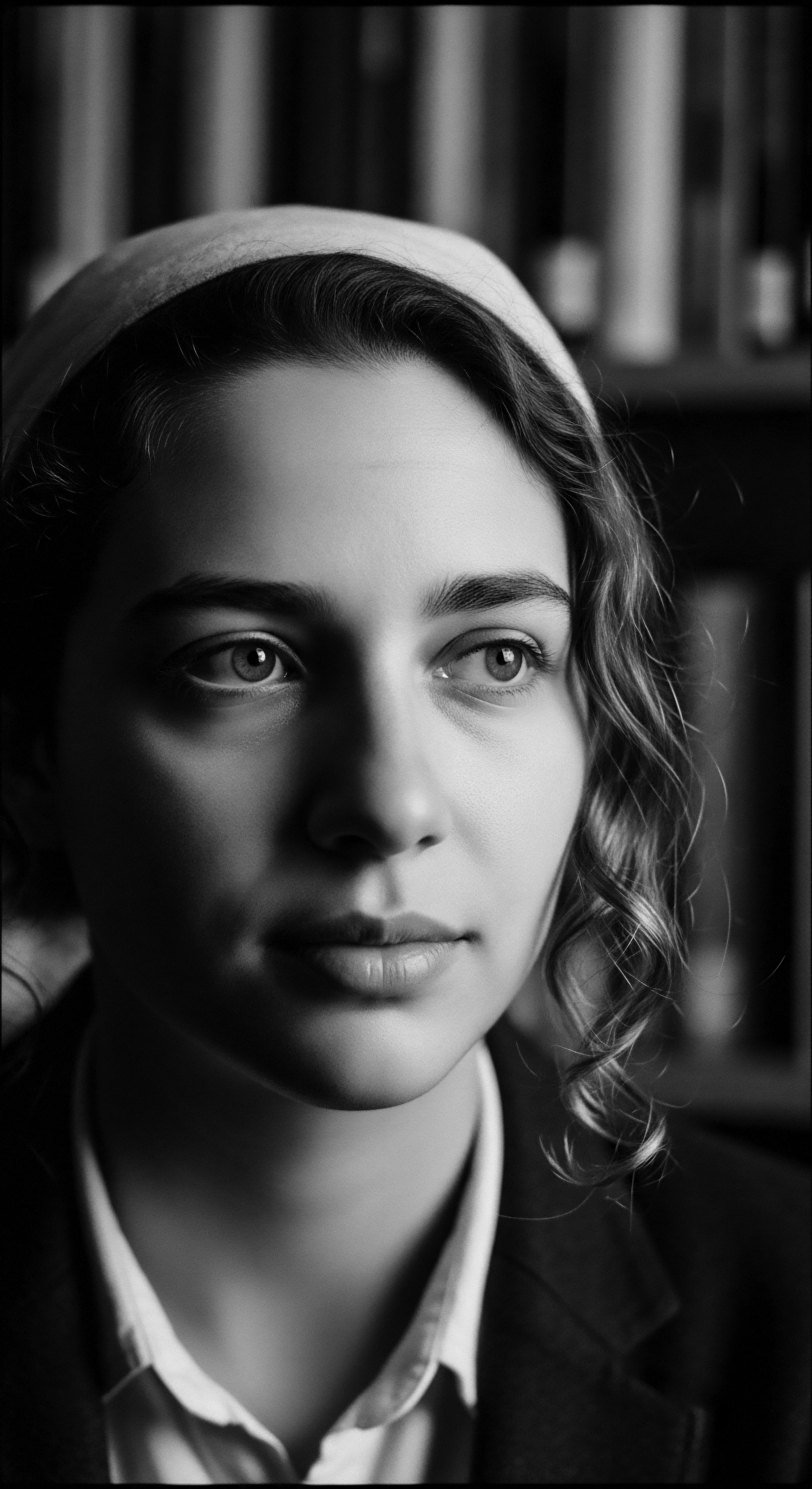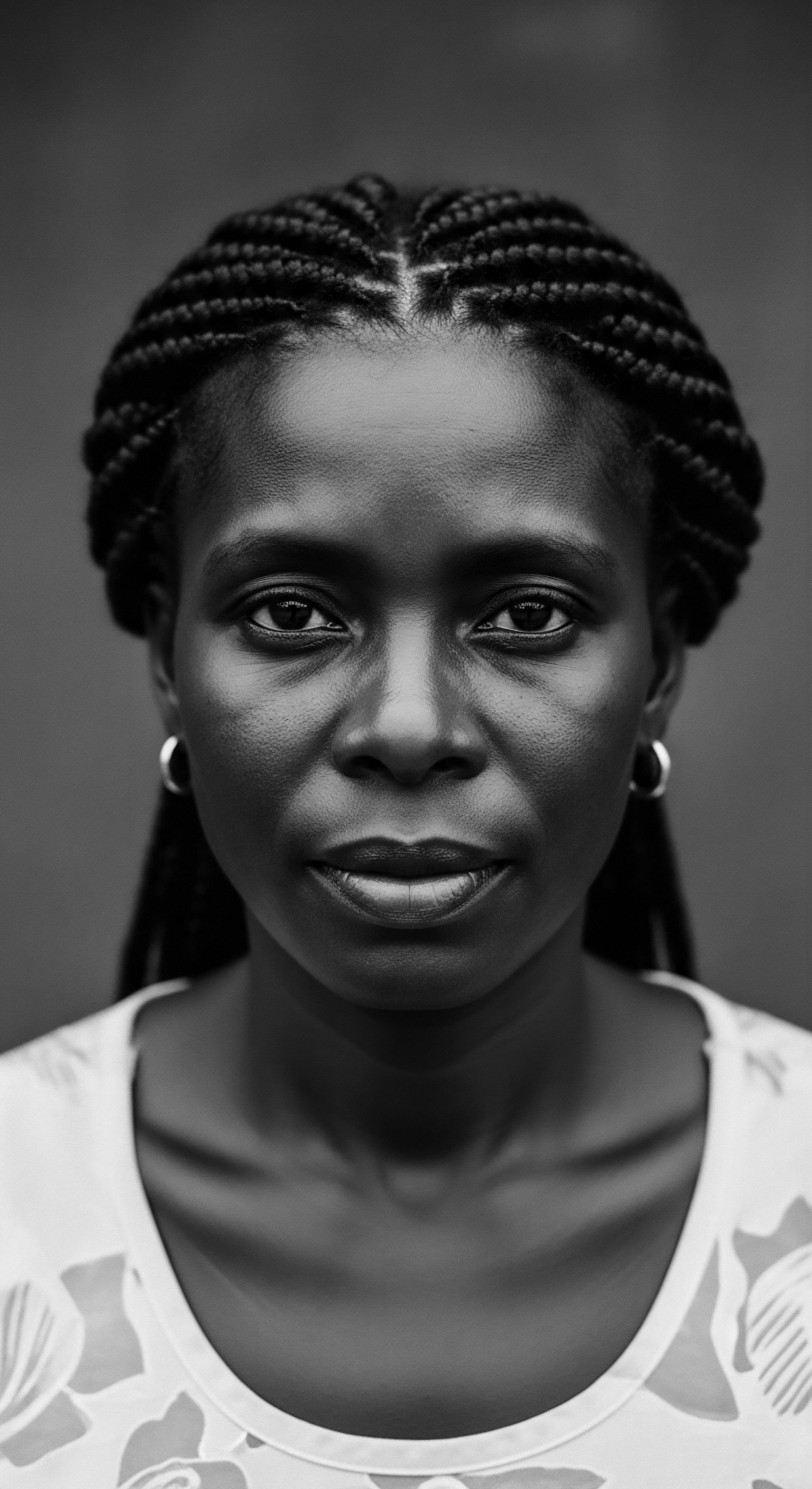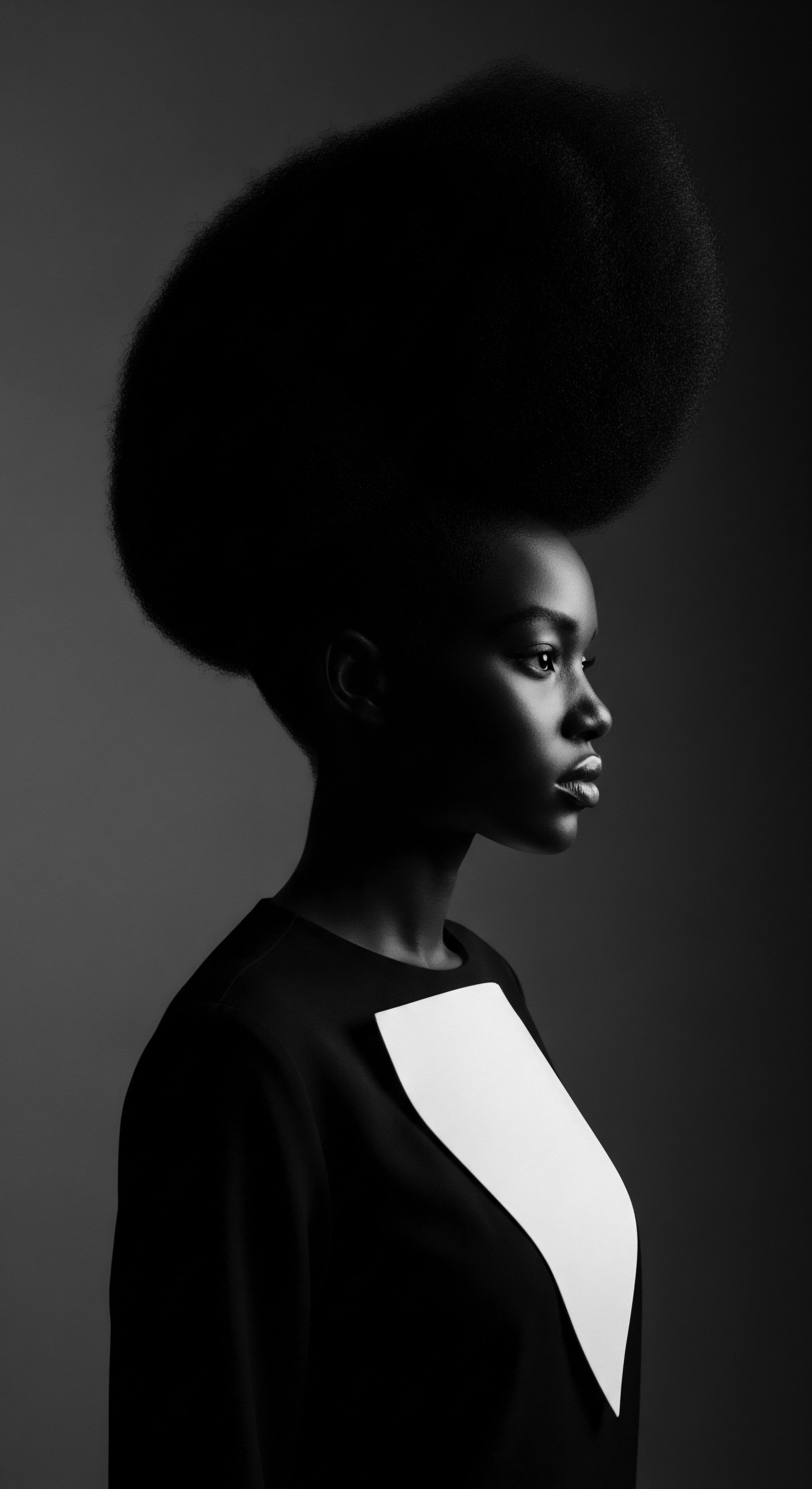
Roots
There exists a whisper, a silent understanding passed through generations, resonating in the very curl of a strand. For those with textured hair, a heritage flows through each coil and wave, a legacy of resilience and ingenious care. This narrative begins not in modern salons, but in distant ancestral lands, where the rhythmic hum of daily life included thoughtful preparation for the quiet hours of night. Consider, for a moment, the meticulous artistry etched into ancient hairstyles, not merely for adornment, but for sustained well-being and symbolic meaning.
How did our forebears, without the tools and products of today, ensure the vitality of their crowning glory as the sun dipped below the horizon? The answers lie in practices born of necessity, observation, and a profound respect for the inherent properties of textured hair.
The biological architecture of textured hair, characterized by its elliptical cross-section and numerous bends, naturally presents distinct needs. These bends and coils, while beautiful, create points of vulnerability where moisture can escape and friction can cause damage. Ancestral communities understood these realities intuitively, long before microscopes revealed the cuticle layers or protein structures. They recognized that hair, like precious fibers, required protection from the nightly contact with rough surfaces, the dry air, and the simple movements of sleep.
The rituals they crafted were not random acts; they were precise, deliberate responses to the elemental biology of their hair, informed by centuries of communal wisdom. The very act of protecting hair at night became a testament to knowledge, a practical application of understanding how the hair fiber interacts with its surroundings.
Ancestral night rituals for textured hair were a testament to intuitive science, safeguarding the delicate architecture of coils and waves from nightly wear.

Hair’s Ancestral Architecture and Care
The diverse textures found within Black and mixed-race communities span a spectrum, from looser waves to tightly coiled patterns. Each variation possesses a unique vulnerability and strength. Historically, in many African societies, the appearance of hair communicated volumes – marital status, age, societal rank, even ethnic identity. A well-maintained coiffure indicated health and standing.
This deep cultural association meant that protecting hair, especially during vulnerable times like sleep, was not a trivial concern. It secured not only physical health of the hair but also the social and spiritual identity it represented.
Early African civilizations meticulously groomed their hair, employing a range of natural substances and methods. This care extended to nightly routines. Women of the Himba tribe in Southwest Africa, for instance, traditionally coat their hair with a paste of ochre, butterfat, and herbs, a practice that likely extends to night protection. This demonstrates an early understanding of sealing moisture and creating a protective barrier around the hair shaft.
- Shea Butter ❉ Sourced primarily from West Africa, this natural butter has been used for centuries to moisturize and protect both skin and hair. Its emollient properties helped seal in moisture, guarding against dryness and breakage.
- Baobab Oil ❉ Extracted from the “Tree of Life” in various African regions, baobab oil, rich in vitamins A, D, and E, as well as fatty acids, offered hydration and repair for hair, serving as a nightly treatment.
- Chebe Powder ❉ From the Basara tribe of Chad, this blend of specific plant seeds and other natural elements has been applied weekly, often braided into the hair, specifically for length retention and moisture balance, directly speaking to protective practices.
These natural elements were applied with intention, often as part of a daily or weekly regimen that included cleansing and styling. The physical act of applying these substances, combined with specific manipulations of the hair, formed the bedrock of nighttime protection.
The practice of hair threading, known as “Irun Kiko” among the Yoruba people of Nigeria as early as the 15th century, offers another window into ancestral hair care. This method involved wrapping sections of hair tightly with thread, effectively stretching the hair and guarding it from external forces. Such practices inherently provided a degree of protection against friction and tangling during sleep, preserving intricate daytime styles and reducing potential damage. The wisdom embedded in these techniques speaks to a deep, practical understanding of textured hair’s needs.

Ritual
The ancestral rituals surrounding night protection for textured hair were far more than simple cosmetic acts. They were, in essence, a choreography of care, a tender dialogue between hair, hand, and herb, often steeped in community and cultural reverence. These practices, honed over countless generations, illustrate a sophisticated, albeit unwritten, science of hair preservation. They recognized that the night, with its hours of unconscious movement, posed a quiet but consistent threat to hair integrity.
The underlying principles of these rituals aligned remarkably with modern understanding of hair health ❉ minimizing friction, maintaining moisture, and preventing tangles. Without the benefit of contemporary fabrics like satin or silk (though silk has an ancient history in other parts of the world, its widespread accessibility in Africa for common nightly hair protection is a later development), ancestral communities relied on materials readily available in their environments and ingenious styling techniques. This adaptation showcases profound innovation and practical application of knowledge, allowing their hair to thrive in challenging climates and demanding lifestyles.

Head Coverings and Wraps ❉ A Shield Against the Night?
One of the most enduring symbols of nighttime hair protection across the African continent and diaspora remains the head covering or wrap. Known by various names such as Duku in Ghana, Gele in Nigeria, or Doek in South Africa, these fabrics served multiple purposes, extending from cultural expression to practical utility. At night, they acted as a crucial barrier. The rough surfaces of sleeping mats or rudimentary pillows could cause significant friction, leading to breakage and tangles for delicate textured strands.
A wrap provided a smooth, enveloping layer, mitigating this abrasion. This was especially vital for preserving intricate daytime styles, some of which took hours or even days to create.
The material chosen for these wraps varied, but natural fibers like cotton, often softened through use, would have been common. While perhaps not possessing the glide of silk, their use still offered substantial protection compared to unprotected hair. The way a wrap was tied also mattered.
A securely fastened wrap prevented hair from shifting too much, holding styles intact and reducing knotting. This thoughtful approach highlights a nuanced understanding of hair dynamics during sleep.

Protective Plaiting and Coiling Practices
Beyond wraps, the deliberate manipulation of hair into specific styles before sleep formed another cornerstone of ancestral night rituals. Braiding and twisting, techniques with roots dating back millennia in Africa (some evidence suggesting cornrows existed 3500 BCE), were not solely for aesthetics or cultural communication. They were powerful protective mechanisms.
When hair is braided or twisted, individual strands are grouped and secured, limiting their ability to rub against each other or external surfaces. This physical containment significantly reduces friction and the potential for mechanical damage. Such styles also compact the hair, making it less prone to tangling and matting overnight, a common challenge for highly textured hair. Consider the various forms these protective styles took:
- Cornrows ❉ Tightly braided rows lying flat against the scalp, often called Canerows in some diaspora regions. These styles held hair close to the head, preventing movement and securing lengths. During the transatlantic slave trade, enslaved people ingeniously used cornrow patterns as coded messages and maps for escape routes, showcasing their deep resourcefulness and cultural continuity.
- Individual Plaits or Braids ❉ Larger, looser braids that might be formed from sections of the hair. These maintained moisture and prevented widespread tangling, allowing for easy styling upon waking.
- Twists ❉ Similar to braids but involving two strands coiled around each other, twists also provided excellent nightly protection by keeping hair grouped and compact.
These styles, often combined with the application of natural oils and butters, created a sealed environment for the hair. The longer the hair could retain its natural moisture, the healthier it remained, preventing the dryness that leads to breakage. This comprehensive approach to care, spanning both physical barriers and internal conditioning, reveals an ancestral foresight in preserving textured hair.
| Era / Context Pre-Colonial Africa |
| Primary Materials Used Natural fibers, animal skins, plant materials, ochre, shea butter, baobab oil |
| Key Nighttime Protection Method Head wraps, intricate braiding (cornrows, individual plaits), threading, oiling, buttering |
| Era / Context Slavery/Diaspora (Early) |
| Primary Materials Used Scraps of fabric, handkerchiefs, cotton rags, adapted natural materials |
| Key Nighttime Protection Method Head wraps (often mandated, then reclaimed as identity), simple braids, makeshift coverings |
| Era / Context Modern (Post-1900s) |
| Primary Materials Used Satin, silk, modern bonnets, pillowcases, hair ties |
| Key Nighttime Protection Method Satin/silk bonnets, scarves, pillowcases, "pineapple method," loose braids/twists |
| Era / Context This table illustrates the continuous adaptation and refinement of nighttime hair protection, reflecting a consistent heritage of care for textured hair across different historical periods. |
The dedication to these nightly rituals, passed from elder to youth, transcended mere practicality. It became a communal activity, a time for storytelling and shared wisdom, further solidifying the cultural importance of hair. Women would gather, often engaging in these extended care sessions together, strengthening social bonds alongside hair strands. The quiet hours of night, therefore, held a special significance, not only for rest but for the quiet, deliberate work of hair preservation, linking individuals to a deep and unbroken chain of heritage.

Relay
The enduring power of ancestral rituals for textured hair protection at night lies in their profound ability to connect elemental science with deeply held cultural meaning. These practices, far from being relics of a distant past, continue to speak to us, offering not only practical solutions but also a deeper connection to heritage and self-understanding. The transmission of this knowledge, often through oral traditions and direct demonstration, served as a living archive, ensuring that the wisdom of safeguarding textured strands persisted across generations, even in the face of profound societal disruption.
The scientific rationale behind these ancestral methods, observed through a contemporary lens, reveals a remarkable intuitive grasp of hair fiber mechanics and physiology. Textured hair, with its unique helical structure, possesses more points of torsion and requires meticulous moisture management. Each bend in the coil creates a potential site for the cuticle to lift, allowing internal moisture to escape and external aggressors, such as friction, to cause fraying and breakage.
Nighttime, a period of sustained contact with bedding, presents a significant challenge to this delicate balance. Ancestral practices addressed these precise vulnerabilities with solutions that modern trichology now validates.

Does Hair’s Microscopic Structure Shape Ancestral Care?
Indeed, the very microscopic architecture of textured hair heavily influenced ancestral care. The spiraled nature of hair strands means they are prone to tangling and knotting, especially when loose. When hair is left unprotected overnight, the continuous movement against bedding can lead to friction, which abrades the outer cuticle layer.
This abrasion can cause the cuticle scales, which typically lie flat, to lift or even chip away, leaving the inner cortex exposed and vulnerable. This exposure results in moisture loss, leading to dryness, brittleness, and ultimately, breakage.
Consider the protective styles like braids and twists. By grouping strands together and securing them, these styles effectively minimize individual strand movement and, consequently, the friction against surfaces. This mechanical protection helps maintain the integrity of the cuticle layer. Furthermore, the application of natural butters and oils before styling acted as occlusive agents, coating the hair shaft and sealing in moisture.
Shea butter, for example, forms a lipid barrier that slows down water evaporation from the hair, maintaining its pliability and strength throughout the night. This dual action – mechanical protection and moisture retention – speaks to a sophisticated, holistic understanding of textured hair’s nocturnal needs.
The generational transfer of ancestral hair care practices for textured hair serves as a profound, living chronicle of resilience and self-preservation.

The Legacy of Head Coverings ❉ Beyond Simple Protection
The role of head coverings, from the ancient duku to the modern satin bonnet, extends beyond simple physical defense. In many African cultures, these coverings held deep spiritual and social meaning. During the transatlantic slave trade, when African hair was often forcibly shaved as a dehumanizing act, head coverings became a clandestine symbol of resistance and retained identity.
Enslaved women, despite their harrowing circumstances, found ways to shield their hair, using available materials to maintain some semblance of ancestral practice, even if the fabrics were rough cotton. This speaks to the unwavering human spirit and the intrinsic value placed upon hair as a connection to self and lineage.
Over time, as communities in the diaspora gained more autonomy, the choice of material became a deliberate act of care. The adoption of smoother fabrics like silk and later, satin, for bonnets and pillowcases, was not accidental. Scientific understanding confirms that these materials cause less friction compared to cotton, reducing tangles, breakage, and moisture absorption from the hair. The evolution of these protective accessories, from necessity to cultural statement to scientifically backed tool, illustrates a continuous, living heritage of adapting and refining care practices for textured hair.
A striking example of how ancestral ingenuity persists can be observed in the widespread contemporary use of satin-lined bonnets. These accessories, while seemingly modern, are a direct continuation of the protective philosophy of ancient head wraps. The shift to satin and silk addresses the specific friction issue that coarser, absorbent fabrics presented, offering a more scientifically optimal solution while preserving the core ancestral purpose of nightly protection.
A survey cited in a dermatological review article recommends wearing satin bonnets or using satin pillowcases while sleeping to reduce hair loss and maintain moisture in Black hair. This contemporary recommendation directly echoes the ancestral wisdom of shielding hair from nightly friction.
| Ancestral Practice Nightly braiding or twisting |
| Heritage Context Preserves complex daytime styles, reduces tangles from manual labor |
| Modern Scientific Alignment Minimizes mechanical friction, reduces knotting, preserves natural curl pattern |
| Ancestral Practice Application of natural butters/oils |
| Heritage Context Moisture retention in arid climates, spiritual significance |
| Modern Scientific Alignment Forms occlusive barrier, prevents transepidermal water loss, nourishes hair shaft |
| Ancestral Practice Head wraps/coverings |
| Heritage Context Social indicator, cultural expression, protection from elements |
| Modern Scientific Alignment Reduces friction with sleeping surfaces, prevents moisture absorption, maintains style |
| Ancestral Practice The consistency between ancient wisdom and contemporary understanding highlights the enduring scientific validity within textured hair heritage. |

What do Ancestral Hair Practices Tell Us about Hair as a Living Entity?
The emphasis on hair protection at night, alongside daily care rituals, strongly suggests that ancestral communities viewed hair not as a static adornment, but as a living entity, responsive to care and environmental influences. This perception aligns with a holistic wellness philosophy where the body, including hair, is interconnected with its environment and spiritual well-being. The act of tending to hair before sleep was therefore an act of reverence, ensuring its vitality and symbolic strength for the new day.
The legacy of these rituals is particularly poignant for Black and mixed-race individuals in the diaspora. Hair, forcibly shorn during enslavement, became a battleground for identity and freedom. The perseverance of night protection rituals, even in the harshest conditions, speaks volumes about the human need to preserve one’s heritage.
These seemingly simple acts ensured the continuity of a profound cultural connection, linking past struggles to present-day affirmations of self and beauty. The deep historical connection of Black hair to identity, resilience, and resistance means that night protection rituals are not just about hair health; they are about honoring a lineage of self-preservation and cultural pride.

Reflection
To contemplate ancestral rituals for protecting textured hair at night is to peer into a profound wellspring of human ingenuity and resilience. These practices, born of deep observation and an intimate kinship with natural rhythms, stand as a testament to the enduring heritage of textured hair care. From the earth’s bounty—the nourishing shea, the fortifying baobab, the preserving chebe—to the meticulous artistry of braided patterns and the enveloping comfort of a well-placed wrap, each element speaks of a conscious, generational effort to honor and sustain the very fiber of identity.
The nocturnal protection of hair became a quiet, powerful act, a nightly reaffirmation of self, community, and an unbroken lineage that stretches back through time. The wisdom of our ancestors, echoing through each carefully tended strand, continues to remind us that true care is a timeless conversation between the self and its inherent heritage.

References
- Byrd, A. D. & Tharps, L. D. (2001). Hair Story ❉ Untangling the Roots of Black Hair in America. St. Martin’s Press.
- Darling-Hammond, L. (2010). The Flat Earth and Flat Hair ❉ A Cultural History of Hair and Education. Teachers College Press.
- Gordon, M. (2013). Hair & Justice ❉ Socio-Legal Aspects of Race and Hair in America. Routledge.
- Guerin, L. & Johnson, L. (2016). Hair and Identity ❉ A Critical Cultural Studies Approach. Peter Lang Publishing.
- Hooks, B. (1995). Art on My Mind ❉ Visual Politics. The New Press.
- Mercer, K. (1994). Welcome to the Jungle ❉ New Positions in Cultural Studies. Routledge.
- Okoro, N. (2019). African Hair. Adinkra House Publishing.
- Patton, T. O. (2006). Our Own Kind of Beautiful ❉ Black Women, Natural Hair, and the Quest for Self-Love. Praeger.
- Sweet, H. (2014). The Hairdresser’s Art ❉ A Cultural History of Hair Care. Bloomsbury Academic.
- Walker, A. (1979). In Search of Our Mothers’ Gardens ❉ Womanist Prose. Harcourt Brace Jovanovich.
